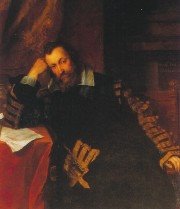
* * *
John Dee
A sixteenth-century portrait of John Dee, artist unknown.
According to Charlotte Fell Smith, this portrait was painted when Dee was 67. It belonged to his grandson Rowland Dee and later to Elias Ashmole, who left it to Oxford University.
John Dee (July 13, 1527-1608) was a noted Welsh mathematician, astronomer, astrologer, geographer, occultist, and consultant to Queen Elizabeth I.
He also devoted much of his life to alchemy, divination, and Hermetic philosophy.
Dee straddled the worlds of science and magic just as they were becoming distinguishable. One of the most learned men of his time, he had lectured to crowded halls at the University of Paris when still in his early twenties.
He was an ardent promoter of mathematics, a respected astronomer and a leading expert in navigation, having trained many of those who would conduct England's voyages of discovery (he coined the term "British Empire").
At the same time, he immersed himself deeply in magic and Hermetic philosophy, devoting the last third of his life almost exclusively to these pursuits. For Dee, as with many of his contemporaries, these activities were not contradictory, but particular aspects of a consistent world-view.
Early life
Dee was born in Tower Ward, London, to a Welsh family, whose surname derived from the Welsh du ("black").
His father Roland was a mercer and minor courtier.
Dee attended the Chelmsford Catholic School (now King Edward VI Grammar School (Chelmsford)), then – from 1543 to 1546 – St. John's College, Cambridge. His great abilities were recognized, and he was made a founding fellow of Trinity College.
In the late 1540s and early 1550s, he travelled in Europe, studying at Leuven and Brussels and lecturing in Paris on Euclid. He studied with Gemma Frisius and became a close friend of the cartographer Gerardus Mercator, returning to England with an important collection of mathematical and astronomical instruments. In 1552, he met Gerolamo Cardano in London: during their acquaintance they investigated a perpetual motion machine as well as a gem purported to have magical properties.[1]
Dee was offered a readership in mathematics at Oxford in 1554, which he declined; he was occupied with writing and perhaps hoping for a better position at court.[2] In 1555, Dee became a member of the Worshipful Company of Mercers, as his father had, through the company's system of patrimony.[3]
That same year, 1555, he was arrested and charged with "calculating" for having cast horoscopes of Queen Mary and Princess Elizabeth; the charges were expanded to treason against Mary.[2][4] Dee appeared in the Star Chamber and exonerated himself, but was turned over to the reactionary Catholic Bishop Bonner for religious examination. His strong and lifelong penchant for secrecy perhaps worsening matters, this entire episode was only the most dramatic in a series of attacks and slanders that would dog Dee through his life. Clearing his name yet again, he soon became a close associate of Bonner.[2]
Dee presented Queen Mary with a visionary plan for the preservation of old books, manuscripts and records and the founding of a national library, in 1556, but his proposal was not taken up.[2] Instead, he expanded his personal library at his house in Mortlake, tirelessly acquiring books and manuscripts in England and on the European Continent.
Dee's library, a center of learning outside the universities, became the greatest in England and attracted many scholars.[5]
When Elizabeth took the throne in 1558, Dee became her trusted advisor on astrological and scientific matters, choosing Elizabeth's coronation date himself.[6][7]
From the 1550s through the 1570s, he served as an advisor to England's voyages of discovery, providing technical assistance in navigation and ideological backing in the creation of a "British Empire", and was the first to use that term.[8] In 1577, Dee published General and Rare Memorials pertayning to the Perfect Arte of Navigation, a work that set out his vision of a maritime empire and asserted English territorial claims on the New World. Dee was acquainted with Humphrey Gilbert and was close to Sir Philip Sidney and his circle.[8]
Dee's glyph, whose meaning he explained in Monas Hieroglyphica.
Dee's glyph, whose meaning he explained in Monas Hieroglyphica.
In 1564, Dee wrote the Hermetic work Monas Hieroglyphica ("The Hieroglyphic Monad"), an exhaustive Cabalistic interpretation of a glyph of his own design, meant to express the mystical unity of all creation. This work was highly valued by many of Dee's contemporaries, but the loss of the secret oral tradition of Dee's milieu makes the work difficult to interpret today.[9]
He published a "Mathematical Preface" to Henry Billingsley's English translation of Euclid's Elements in 1570, arguing the central importance of mathematics and outlining mathematics' influence on the other arts and sciences.[10] Intended for an audience outside the universities, it proved to be Dee's most widely influential and frequently reprinted work.[11]
NAME Dee, John
ALTERNATIVE NAMES Dr Dee
SHORT DESCRIPTION British mathematician, astronomer, astrologer, geographer, occultist, alchemist and philosopher.
DATE OF BIRTH 13 July 1527
PLACE OF BIRTH London
DATE OF DEATH c. 1608
PLACE OF DEATH Mortlake, Surrey
Retrieved from "http://en.wikipedia.org/wiki/John_Dee"
http://en.wikipedia.org/wiki/John_Dee
* * *

No comments:
Post a Comment